Acidic
Basic
Neutral
Shaped
Unshaped
Metal & Metallurgy
Cement
Glass & Ceramics
Power Generation
Others
North America
Europe
South America
Asia Pacific
Middle East and Africa
North America Outlook (USD Billion, 2019-2035)
North America Refractory Material Market by Chemistry Type
Acidic
Basic
Neutral
North America Refractory Material Market by Form Type
Shaped
Unshaped
North America Refractory Material Market by End Use Type
Metal & Metallurgy
Cement
Glass & Ceramics
Power Generation
Others
North America Refractory Material Market by Regional Type
US
Canada
US Outlook (USD Billion, 2019-2035)
US Refractory Material Market by Chemistry Type
Acidic
Basic
Neutral
US Refractory Material Market by Form Type
Shaped
Unshaped
US Refractory Material Market by End Use Type
Metal & Metallurgy
Cement
Glass & Ceramics
Power Generation
Others
CANADA Outlook (USD Billion, 2019-2035)
CANADA Refractory Material Market by Chemistry Type
Acidic
Basic
Neutral
CANADA Refractory Material Market by Form Type
Shaped
Unshaped
CANADA Refractory Material Market by End Use Type
Metal & Metallurgy
Cement
Glass & Ceramics
Power Generation
Others
Europe Outlook (USD Billion, 2019-2035)
Europe Refractory Material Market by Chemistry Type
Acidic
Basic
Neutral
Europe Refractory Material Market by Form Type
Shaped
Unshaped
Europe Refractory Material Market by End Use Type
Metal & Metallurgy
Cement
Glass & Ceramics
Power Generation
Others
Europe Refractory Material Market by Regional Type
Germany
UK
France
Russia
Italy
Spain
Rest of Europe
GERMANY Outlook (USD Billion, 2019-2035)
GERMANY Refractory Material Market by Chemistry Type
Acidic
Basic
Neutral
GERMANY Refractory Material Market by Form Type
Shaped
Unshaped
GERMANY Refractory Material Market by End Use Type
Metal & Metallurgy
Cement
Glass & Ceramics
Power Generation
Others
UK Outlook (USD Billion, 2019-2035)
UK Refractory Material Market by Chemistry Type
Acidic
Basic
Neutral
UK Refractory Material Market by Form Type
Shaped
Unshaped
UK Refractory Material Market by End Use Type
Metal & Metallurgy
Cement
Glass & Ceramics
Power Generation
Others
FRANCE Outlook (USD Billion, 2019-2035)
FRANCE Refractory Material Market by Chemistry Type
Acidic
Basic
Neutral
FRANCE Refractory Material Market by Form Type
Shaped
Unshaped
FRANCE Refractory Material Market by End Use Type
Metal & Metallurgy
Cement
Glass & Ceramics
Power Generation
Others
RUSSIA Outlook (USD Billion, 2019-2035)
RUSSIA Refractory Material Market by Chemistry Type
Acidic
Basic
Neutral
RUSSIA Refractory Material Market by Form Type
Shaped
Unshaped
RUSSIA Refractory Material Market by End Use Type
Metal & Metallurgy
Cement
Glass & Ceramics
Power Generation
Others
ITALY Outlook (USD Billion, 2019-2035)
ITALY Refractory Material Market by Chemistry Type
Acidic
Basic
Neutral
ITALY Refractory Material Market by Form Type
Shaped
Unshaped
ITALY Refractory Material Market by End Use Type
Metal & Metallurgy
Cement
Glass & Ceramics
Power Generation
Others
SPAIN Outlook (USD Billion, 2019-2035)
SPAIN Refractory Material Market by Chemistry Type
Acidic
Basic
Neutral
SPAIN Refractory Material Market by Form Type
Shaped
Unshaped
SPAIN Refractory Material Market by End Use Type
Metal & Metallurgy
Cement
Glass & Ceramics
Power Generation
Others
REST OF EUROPE Outlook (USD Billion, 2019-2035)
REST OF EUROPE Refractory Material Market by Chemistry Type
Acidic
Basic
Neutral
REST OF EUROPE Refractory Material Market by Form Type
Shaped
Unshaped
REST OF EUROPE Refractory Material Market by End Use Type
Metal & Metallurgy
Cement
Glass & Ceramics
Power Generation
Others
APAC Outlook (USD Billion, 2019-2035)
APAC Refractory Material Market by Chemistry Type
Acidic
Basic
Neutral
APAC Refractory Material Market by Form Type
Shaped
Unshaped
APAC Refractory Material Market by End Use Type
Metal & Metallurgy
Cement
Glass & Ceramics
Power Generation
Others
APAC Refractory Material Market by Regional Type
China
India
Japan
South Korea
Malaysia
Thailand
Indonesia
Rest of APAC
CHINA Outlook (USD Billion, 2019-2035)
CHINA Refractory Material Market by Chemistry Type
Acidic
Basic
Neutral
CHINA Refractory Material Market by Form Type
Shaped
Unshaped
CHINA Refractory Material Market by End Use Type
Metal & Metallurgy
Cement
Glass & Ceramics
Power Generation
Others
INDIA Outlook (USD Billion, 2019-2035)
INDIA Refractory Material Market by Chemistry Type
Acidic
Basic
Neutral
INDIA Refractory Material Market by Form Type
Shaped
Unshaped
INDIA Refractory Material Market by End Use Type
Metal & Metallurgy
Cement
Glass & Ceramics
Power Generation
Others
JAPAN Outlook (USD Billion, 2019-2035)
JAPAN Refractory Material Market by Chemistry Type
Acidic
Basic
Neutral
JAPAN Refractory Material Market by Form Type
Shaped
Unshaped
JAPAN Refractory Material Market by End Use Type
Metal & Metallurgy
Cement
Glass & Ceramics
Power Generation
Others
SOUTH KOREA Outlook (USD Billion, 2019-2035)
SOUTH KOREA Refractory Material Market by Chemistry Type
Acidic
Basic
Neutral
SOUTH KOREA Refractory Material Market by Form Type
Shaped
Unshaped
SOUTH KOREA Refractory Material Market by End Use Type
Metal & Metallurgy
Cement
Glass & Ceramics
Power Generation
Others
MALAYSIA Outlook (USD Billion, 2019-2035)
MALAYSIA Refractory Material Market by Chemistry Type
Acidic
Basic
Neutral
MALAYSIA Refractory Material Market by Form Type
Shaped
Unshaped
MALAYSIA Refractory Material Market by End Use Type
Metal & Metallurgy
Cement
Glass & Ceramics
Power Generation
Others
THAILAND Outlook (USD Billion, 2019-2035)
THAILAND Refractory Material Market by Chemistry Type
Acidic
Basic
Neutral
THAILAND Refractory Material Market by Form Type
Shaped
Unshaped
THAILAND Refractory Material Market by End Use Type
Metal & Metallurgy
Cement
Glass & Ceramics
Power Generation
Others
INDONESIA Outlook (USD Billion, 2019-2035)
INDONESIA Refractory Material Market by Chemistry Type
Acidic
Basic
Neutral
INDONESIA Refractory Material Market by Form Type
Shaped
Unshaped
INDONESIA Refractory Material Market by End Use Type
Metal & Metallurgy
Cement
Glass & Ceramics
Power Generation
Others
REST OF APAC Outlook (USD Billion, 2019-2035)
REST OF APAC Refractory Material Market by Chemistry Type
Acidic
Basic
Neutral
REST OF APAC Refractory Material Market by Form Type
Shaped
Unshaped
REST OF APAC Refractory Material Market by End Use Type
Metal & Metallurgy
Cement
Glass & Ceramics
Power Generation
Others
South America Outlook (USD Billion, 2019-2035)
South America Refractory Material Market by Chemistry Type
Acidic
Basic
Neutral
South America Refractory Material Market by Form Type
Shaped
Unshaped
South America Refractory Material Market by End Use Type
Metal & Metallurgy
Cement
Glass & Ceramics
Power Generation
Others
South America Refractory Material Market by Regional Type
Brazil
Mexico
Argentina
Rest of South America
BRAZIL Outlook (USD Billion, 2019-2035)
BRAZIL Refractory Material Market by Chemistry Type
Acidic
Basic
Neutral
BRAZIL Refractory Material Market by Form Type
Shaped
Unshaped
BRAZIL Refractory Material Market by End Use Type
Metal & Metallurgy
Cement
Glass & Ceramics
Power Generation
Others
MEXICO Outlook (USD Billion, 2019-2035)
MEXICO Refractory Material Market by Chemistry Type
Acidic
Basic
Neutral
MEXICO Refractory Material Market by Form Type
Shaped
Unshaped
MEXICO Refractory Material Market by End Use Type
Metal & Metallurgy
Cement
Glass & Ceramics
Power Generation
Others
ARGENTINA Outlook (USD Billion, 2019-2035)
ARGENTINA Refractory Material Market by Chemistry Type
Acidic
Basic
Neutral
ARGENTINA Refractory Material Market by Form Type
Shaped
Unshaped
ARGENTINA Refractory Material Market by End Use Type
Metal & Metallurgy
Cement
Glass & Ceramics
Power Generation
Others
REST OF SOUTH AMERICA Outlook (USD Billion, 2019-2035)
REST OF SOUTH AMERICA Refractory Material Market by Chemistry Type
Acidic
Basic
Neutral
REST OF SOUTH AMERICA Refractory Material Market by Form Type
Shaped
Unshaped
REST OF SOUTH AMERICA Refractory Material Market by End Use Type
Metal & Metallurgy
Cement
Glass & Ceramics
Power Generation
Others
MEA Outlook (USD Billion, 2019-2035)
MEA Refractory Material Market by Chemistry Type
Acidic
Basic
Neutral
MEA Refractory Material Market by Form Type
Shaped
Unshaped
MEA Refractory Material Market by End Use Type
Metal & Metallurgy
Cement
Glass & Ceramics
Power Generation
Others
MEA Refractory Material Market by Regional Type
GCC Countries
South Africa
Rest of MEA
GCC COUNTRIES Outlook (USD Billion, 2019-2035)
GCC COUNTRIES Refractory Material Market by Chemistry Type
Acidic
Basic
Neutral
GCC COUNTRIES Refractory Material Market by Form Type
Shaped
Unshaped
GCC COUNTRIES Refractory Material Market by End Use Type
Metal & Metallurgy
Cement
Glass & Ceramics
Power Generation
Others
SOUTH AFRICA Outlook (USD Billion, 2019-2035)
SOUTH AFRICA Refractory Material Market by Chemistry Type
Acidic
Basic
Neutral
SOUTH AFRICA Refractory Material Market by Form Type
Shaped
Unshaped
SOUTH AFRICA Refractory Material Market by End Use Type
Metal & Metallurgy
Cement
Glass & Ceramics
Power Generation
Others
REST OF MEA Outlook (USD Billion, 2019-2035)
REST OF MEA Refractory Material Market by Chemistry Type
Acidic
Basic
Neutral
REST OF MEA Refractory Material Market by Form Type
Shaped
Unshaped
REST OF MEA Refractory Material Market by End Use Type
Metal & Metallurgy
Cement
Glass & Ceramics
Power Generation
Others
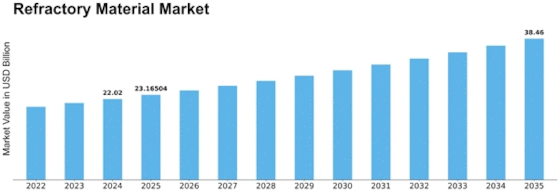

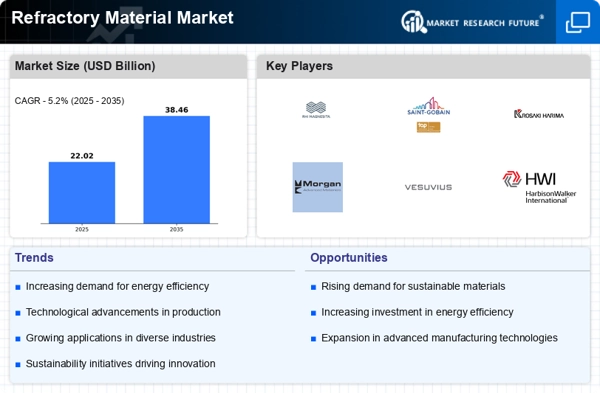
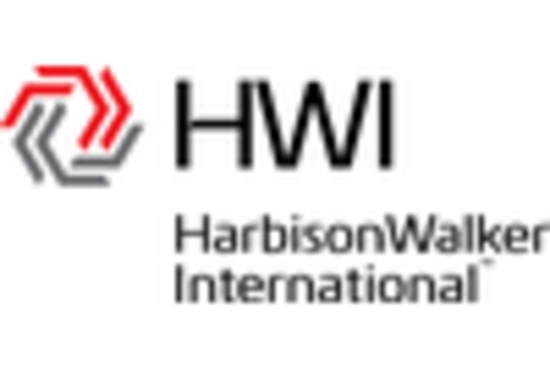
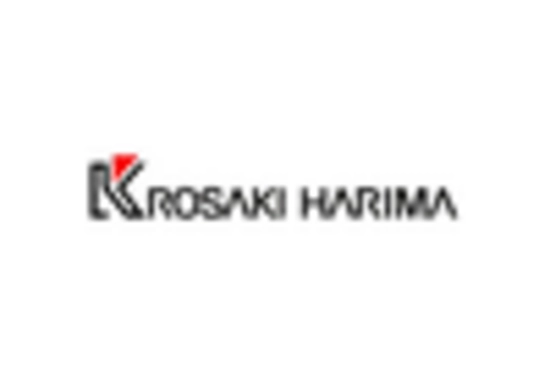
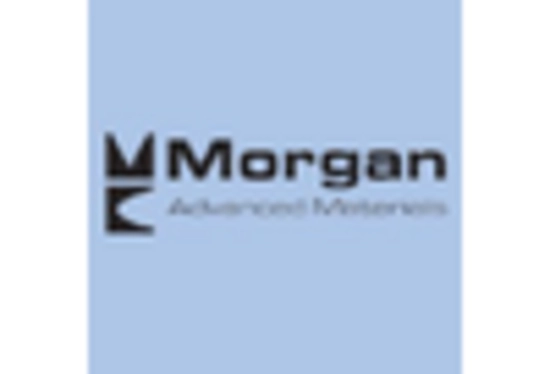
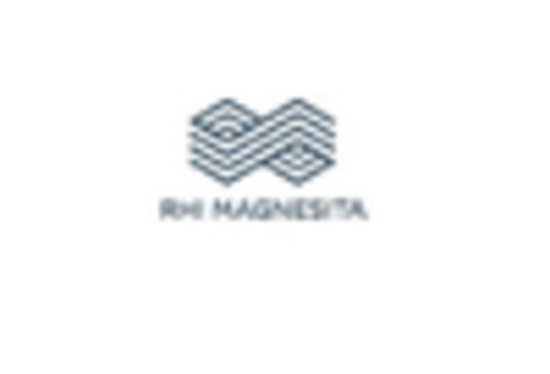

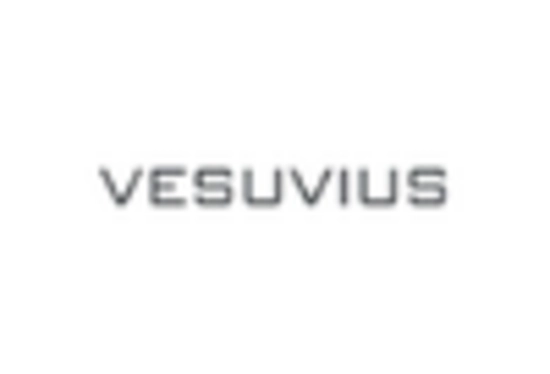









Leave a Comment